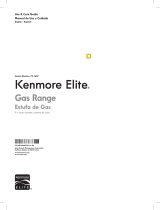23
ge.com
Soporte al consumidor
OperaciónSeguridad
Instrucciones de
instalación
Solucionar problemas
Puerta del horno de levantar
La puerta del horno es desmontable, sin embargo es
pesada. Posiblemente necesite ayuda para quitar y
reemplazar la puerta.
Para retirar la puerta, ábrala unas cuantas
pulgadas hasta la posición de freno especial
que mantiene la puerta abierta. Tómela
firmemente de cada lado y levante la puerta
hacia arriba y hacia fuera de las bisagras.
NOTA: Tenga cuidado de no colocar las manos entre
la bisagra y el marco de la puerta del horno ya que
la bisagra se puede escapar y le atraparía los dedos.
Para reemplazar la puerta, cerciórese de que
las bisagras estén en la posición de freno
especial. Coloque las ranuras de la parte
inferior de la puerta justamente sobre las
bisagras. Luego baje la puerta lenta y
uniformemente sobre ambas bisagras al
mismo tiempo. Si las bisagras se escapan del
marco del horno, ábralas nuevamente.
Para limpiar el interior de la puerta:
■ No permita que agua excesiva corra hacia
los agujeros o las ranuras en la puerta.
■ El área afuera de la junta puede limpiarse
con una esponja de acero con detergente
o con una almohadilla plástica.
Para limpiar el exterior de la puerta:
■ Use agua y jabón para limpiar
completamente la parte superior, los
lados y el frente de la puerta del horno.
Enjuague bien. También puede usar un
limpiador de vidrios para limpiar el vidrio
por fuera de la puerta.
■ Los derramamientos de platos
marinados, jugos de frutas, salsas de
tomate y líquidos para cocinar que
contengan ácidos posiblemente causen
decoloración y se deben limpiar
inmediatamente. Cuando la superficie
este fría, limpie y enjuague.
■ No use limpiadores para hornos,
limpiadores en polvo o abrasivos fuertes
en la parte exterior de la puerta.
Fondo del horno
El fondo del horno tiene un acabado en
esmalte de porcelana. Para limpiar más
fácilmente, proteja el fondo del horno de
derramamientos excesivos colocando una
lata de galletas en el estante debajo del que
está usando para cocinar. Esto es
particularmente importante cuando hornea
un pastel de frutas u otros alimentos con
alto contenido de ácido. Los rellenos de
fruta caliente o de otros alimentos
altamente ácidos (como tomates, chucrut
y salsas con vinagre o jugo de limón)
pueden causar marcas y dañar la superficie
del esmalte de porcelana, por tanto se debe
limpiar inmediatamente.
No recomendamos el uso de papel de
aluminio en el fondo del horno. Puede
afectar el flujo de aire si se bloquean los
orificios y se puede concentrar el calor en el
fondo del horno, dando como resultado un
desempeño inadecuado al hornear.
Para limpiar derrames, use jabón y agua, un
limpiador abrasivo o una esponja de acero
con detergente. Enjuague bien para
remover el detergente.
Bandeja y rejilla para asar
Después de asar a la parrilla, retire la
bandeja para asar del horno. Retire la rejilla
de la bandeja. Cuidadosamente vierta la
grasa de la bandeja en un contenedor
apropiado. Lave y enjuague la bandeja y la
rejilla en agua caliente con una esponjilla
plástica con jabón.
Si hay alimentos quemados, rocíe la rejilla
con detergente mientras está caliente y
cubra con toallas de papel húmedas o con
un paño para secar platos. Poner
en remojo la bandeja ayuda a retirar los
alimentos quemados.
La bandeja y la rejilla también se pueden
limpiar con un limpiador de hornos
comercial.
Tanto la bandeja como la rejilla se pueden
lavar en una lavadora de platos.
No guarde en ningún sitio de la estufa la
bandeja o la rejilla si están sucios.
PRECAUCIÓN: No limpie la
bandeja o la rejilla en un horno de limpieza
automática.
Levante la puerta directamente hacia
arriba y extráigala de las bisagras.
La junta está diseñada con una franja
en el fondo para permitir que ocurra
una circulación del aire apropiada.
No restriegue o limpie la junta de la
puerta—tiene una tolerancia
extremadamente baja a la abrasión.
Si usted nota que la junta de la puerta
se está desgastando, o que se está
deshilachando o dañándose o que de
alguna forma se está saliendo de su
lugar, usted debe reemplazarla.
Rejilla
Bandeja
























































































